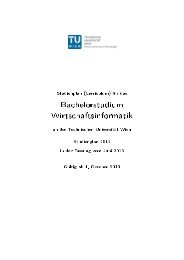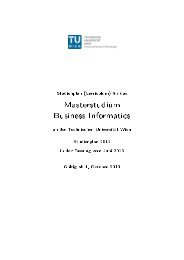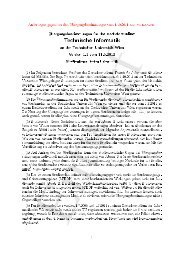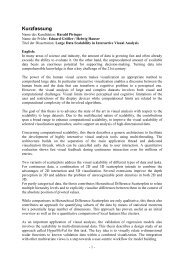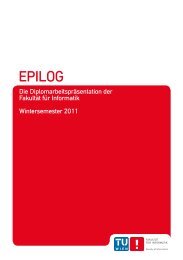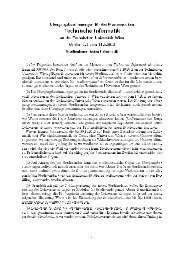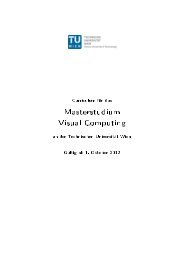Abstract-Band - Fakultät für Informatik, TU Wien - Technische ...
Abstract-Band - Fakultät für Informatik, TU Wien - Technische ...
Abstract-Band - Fakultät für Informatik, TU Wien - Technische ...
Sie wollen auch ein ePaper? Erhöhen Sie die Reichweite Ihrer Titel.
YUMPU macht aus Druck-PDFs automatisch weboptimierte ePaper, die Google liebt.
a mobile device acting as a surrogate for the attention of a user. By tracking<br />
this small area, it can be reconstructed what a user has read. With this approach,<br />
studies are made which show possibilities of usage of such a tool. Also a<br />
prototype of an analysis-portal was created that can be used to analyze the<br />
recorded data. This tool was used to analyze the data from a study done with<br />
students of the course Applied Web Data Extraction and Integration. Metrics<br />
and indicators for web usability are identified that are not available with<br />
traditional 'inter-page-level' approaches like Google Analytics focusing on the<br />
navigation path between web pages. The analysis shows how people behave<br />
differently when accessing a desktop or mobile version of a website with their<br />
smartphone and which differences and similarities can be found when comparing<br />
different websites of one domain to each other. Some key performance<br />
indicators are theoretically discussed and some were implemented and their<br />
results are shown.<br />
Arbeitsbereich Knowledge Based Systems<br />
Shqiponja Ahmetaj<br />
Planning in Graph Databases under Description Logic Constraints<br />
Studium: Masterstudium DDP Computational Logic (Erasmus-Mundus)<br />
BetreuerIn: O.Univ.Prof. Dr. Thomas Eiter<br />
In this thesis, we propose a framework for planning in graph databases. To the<br />
best of our knowledge, this is the first attempt to formally define planning in<br />
such setting. We use an expressive action language that is already defined by<br />
an earlier work. This language is expressed through a DL that has the feature to<br />
introduce new values to the data. Graph databases are seen as finite DL<br />
interpretations. We identify some interesting reasoning tasks, relevant for the<br />
setting we consider. The standard one is plan-existence, which corresponds in<br />
trying to find a plan for a given instance of a planning problem. We investigate<br />
two variants of the problem. The difference between them is that in one of<br />
them we do not allow the transactions to introduce fresh constants. We prove<br />
that deciding plan-existence for the variation without fresh constants is PSpacecomplete.<br />
After applying several syntactic restrictions, we are able to determine<br />
NlogSpace and NP-hard cases. We are also able to provide several polynomial<br />
algorithms for some other cases. In addition, to get some insights to<br />
the relationship between our formalism and STRIPS, which is a classical approach<br />
to planning, we investigate whether planning in our setting can be<br />
reduced to STRIPS. We show that such encoding is possible under some<br />
syntactical restrictions. In this way, STRIPS planners can be exploited to solve<br />
our planning problem. Furthermore, we study the variation, where the transactions<br />
are allowed to introduce fresh constants. Intuitively, this makes<br />
planning more involved. We are able to single out some cases in this setting<br />
that can be reduced to planning without fresh constants. In this way we prove<br />
that those cases are in PSpace.<br />
37



